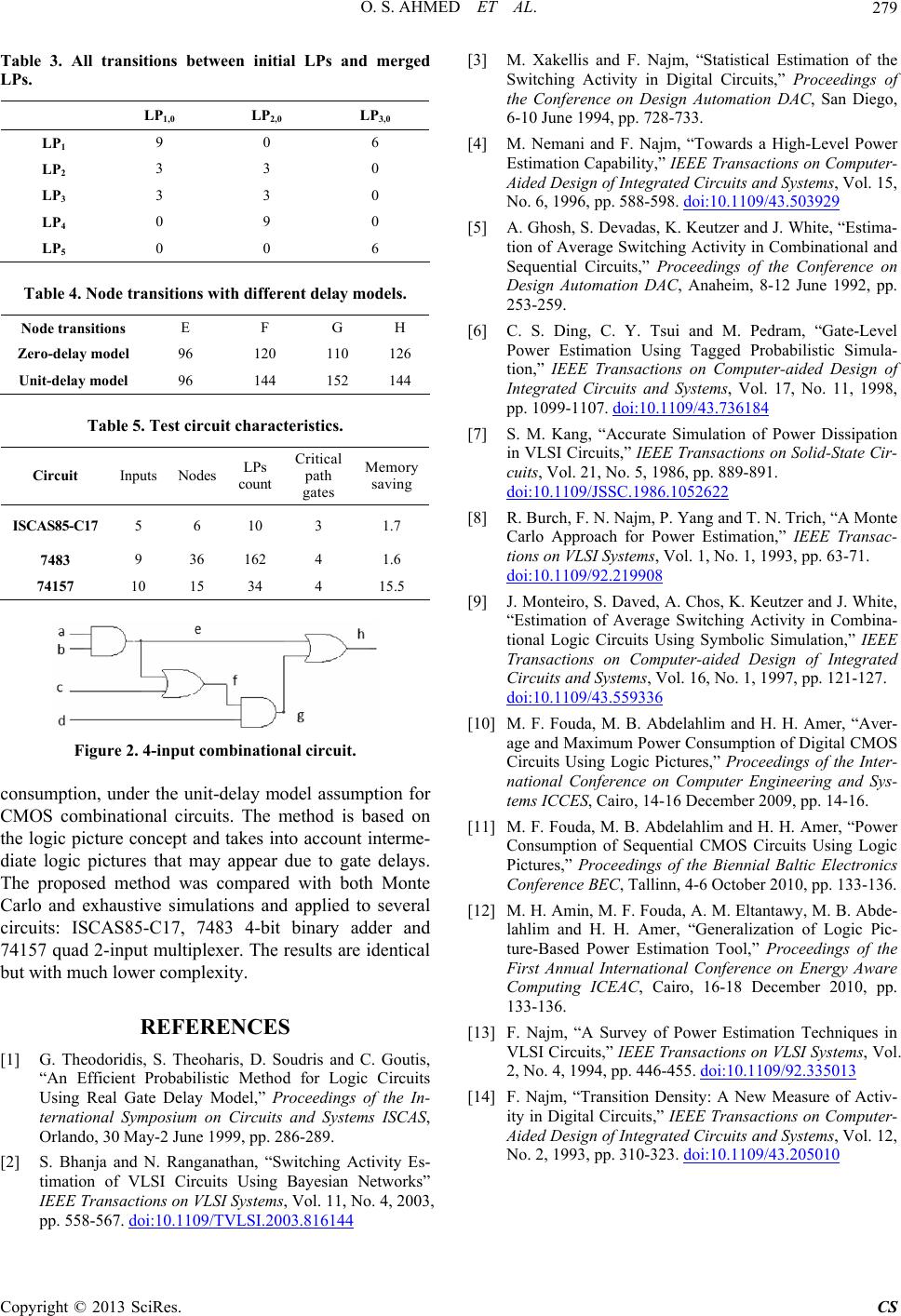
O. S. AHMED ET AL. 279
Table 3. All transitions between initial LPs and merged
LPs.
LP1,0 LP2,0 LP3,0
LP1 9 0 6
LP2 3 3 0
L3 P3 3 0
LP4 0 9 0
LP5 0 0 6
Ta. Node trans with dit delay m
Nonsitions E
G H
ble 4sitionfferenodels.
de tra
F
Zero-delay model 96 120 110 126
Unit-delay model 96 144 152 144
Tesit chterist
Circuit Inputs
Nodes L
count
Crit
path Me
saving
Table 5.t circuaracics.
Ps ical
gates
mory
ISCAS85-C17 5 6 10 1.7 3
7483 9 36 162 4 1.6
74157 10 15 34 4 15.5
Figure 2. 4-input combinational circuit.
consumption, under the unit-delay model assump
CMOS coba
e logic interme-
. Soudris and C. Goutis,
“An Efficient Probabilistic Method for Logic Circuits
Using Real Geedings of the In-
ternational Syd Systems ISCAS
4
tion f
sed on
or
mbinational circuits. The method is
picture concept and takes into account th
diate logic pictures that may appear due to gate delays.
The proposed method was compared with both Monte
Carlo and exhaustive simulations and applied to several
circuits: ISCAS85-C17, 7483 4-bit binary adder and
74157 quad 2-inpu t multiplexer. Th e results are identical
but with much lower complexity.
REFERENCES
[1] G. Theodoridis, S. Theoharis, D
ate Delay Model,” Proc
mposium on Circuits an,
Orlando, 30 May-2 June 1999, pp. 286-289.
[2] S. Bhanja and N. Ranganathan, “Switching Activity Es-
timation of VLSI Circuits Using Bayesian Networks”
IEEE Transactions on VLSI Systems, Vol. 11, No. 4, 2003,
pp. 558-567. doi:10.1109/TVLSI.2003.81614
an Diego,
cuits and Systems, Vol. 15,
[3] M. Xakellis and F. Najm, “Statistical Estimation of the
Switching Activity in Digital Circuits,” Proceedings of
the Conference on Design Automation DAC, S
6-10 June 1994, pp. 728-733.
[4] M. Nemani and F. Najm, “Towards a High-Level Power
Estimation Capability,” IEEE Transactions on Computer-
Aided Design of Integrated Cir
No. 6, 1996, pp. 588-598. doi:10.1109/43.503929
[5] A. Ghosh, S. Devadas, K. Keutzer and J. White, “Esti ma-
tion of Average Switching Activity in Combinational and
Sequential Circuits,” Proceedings of the Conference on
E Transactions on Computer-aided Design of
Design Automation DAC, Anaheim, 8-12 June 1992, pp.
253-259.
[6] C. S. Ding, C. Y. Tsui and M. Pedram, “Gate-Level
Power Estimation Using Tagged Probabilistic Simula-
tion,” IEE
Integrated Circuits and Systems, Vol. 17, No. 11, 1998,
pp. 1099-1107. doi:10.1109/43.736184
[7] S. M. Kang, “Accurate Simulation of Power Dissipation
in VLSI Circuits,” IEEE Transactions on Solid-State Cir-
cuits, Vol. 21, No. 5, 1986, pp. 889-891.
doi:10.1109/JSSC.1986.1052622
[8] R. Burch, F. N. Najm, P. Yang and T. N. Trich, “A Monte
Carlo Approach for Power Estimation,”
tions on VLSI Systems, Vol. 1, No. IEEE Transac-
1, 1993, pp. 63-71.
doi:10.1109/92.219908
[9] J. Monteiro, S. Daved, A. Chos, K. Keutzer and J. White,
“Estimation of Average Switching Activity in Combin
tional Logic Circuits Usa-
ing Symbolic Simulation,” IEEE
Transactions on Computer-aided Design of Integrated
Circuits and Systems, Vol. 16, No. 1, 1997, pp. 121-127.
doi:10.1109/43.559336
[10] M. F. Fouda, M. B. Abdelahlim and H. H. Amer, “Aver-
age and Maximum Power Consumption of Digital CMOS
Circuits Using Logic Pic
tures,” Proceedings of the Inter-
ics
994, pp. 446-455. doi:10.1109/92.335013
national Conference on Computer Engineering and Sys-
tems ICCES, Cairo, 14-16 December 2009, pp. 14-16.
[11] M. F. Fouda, M. B. Abdelahlim and H. H. Amer, “Power
Consumption of Sequential CMOS Circuits Using Logic
Pictures,” Proceedings of the Biennial Baltic Electron
Conference BEC, Tallinn, 4-6 October 2010, pp. 133-136.
[12] M. H. Amin, M. F. Fouda, A. M. Eltantawy, M. B. Abde-
lahlim and H. H. Amer, “Generalization of Logic Pic-
ture-Based Power Estimation Tool,” Proceedings of the
First Annual International Conference on Energy Aware
Computing ICEAC, Cairo, 16-18 December 2010, pp.
133-136.
[13] F. Najm, “A Survey of Power Estimation Techniques in
VLSI Circuits,” IEEE Transactions on VLSI Systems, Vol.
2, No. 4, 1
l. 12,
[14] F. Najm, “Transition Density: A New Measure of Activ-
ity in Digital Circuits,” IEEE Transactions on Computer-
Aided Design of Integrated Circuits and Systems, Vo
No. 2, 1993, pp. 310-323. doi:10.1109/43.205010
Copyright © 2013 SciRes. CS